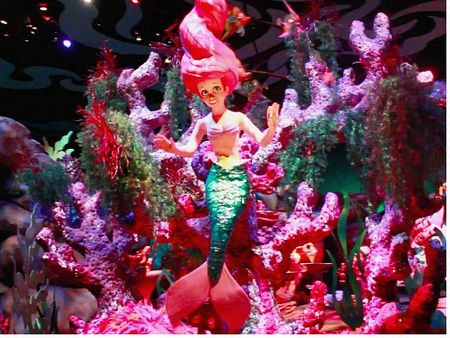Here's a scene in Pooh's Huny Hunt which makes good use of incandescent light,

The mural in the background looks like it is lit with cfls, and the Pooh/tree looks like incandescent light. And you've got shadows, given the "white light" as Eddie Sotto said, you have to stage this differently from a dark scene by using 3-D props and colors and would look about the same under the sun.
Below is more a dark scene (those they obviously use some incandescents), with the use of some UV light, and the portions of the ride which are completely dark aren't decorated or staged. If they turned off the show lights, the dark scene would look a lot more fake than the forest scene.

Dark rides techniques focuses the guest's attention on certain features, and you have trouble telling even how big a room you're in.
My best example would be the Jelly Fish in Nemo, it is hard to tell how big the room is, and you get that "magically eery" look of UV.
Little Mermaid's "Under the Sea" scene is big, but when I rode it I could tell pretty much what the dimension of the room is and could see the articulations in the animatronics and how they were attached as the show floor is very well lit up with incandescents. The "ceiling" is dark, but due to the presence of spotlights and wavy things, and the metal bars holding fish, it doesn't hide as much as dark rides, IMHO, where the shadows really swallow stuff up.

They obviously didn't want to use blue, or green light too much as it would make Ariel look different, BUT if they used special paints under blue and green light, along with a small amount of incandescent, I think it would have done a better job of making guests feel like they are under the ocean. There's just a too "jazzy" feel to the scene, like we're seeing a Little Mermaid parade float go by in the middle of the night.

The mural in the background looks like it is lit with cfls, and the Pooh/tree looks like incandescent light. And you've got shadows, given the "white light" as Eddie Sotto said, you have to stage this differently from a dark scene by using 3-D props and colors and would look about the same under the sun.
Below is more a dark scene (those they obviously use some incandescents), with the use of some UV light, and the portions of the ride which are completely dark aren't decorated or staged. If they turned off the show lights, the dark scene would look a lot more fake than the forest scene.

Dark rides techniques focuses the guest's attention on certain features, and you have trouble telling even how big a room you're in.
My best example would be the Jelly Fish in Nemo, it is hard to tell how big the room is, and you get that "magically eery" look of UV.
Little Mermaid's "Under the Sea" scene is big, but when I rode it I could tell pretty much what the dimension of the room is and could see the articulations in the animatronics and how they were attached as the show floor is very well lit up with incandescents. The "ceiling" is dark, but due to the presence of spotlights and wavy things, and the metal bars holding fish, it doesn't hide as much as dark rides, IMHO, where the shadows really swallow stuff up.

They obviously didn't want to use blue, or green light too much as it would make Ariel look different, BUT if they used special paints under blue and green light, along with a small amount of incandescent, I think it would have done a better job of making guests feel like they are under the ocean. There's just a too "jazzy" feel to the scene, like we're seeing a Little Mermaid parade float go by in the middle of the night.
